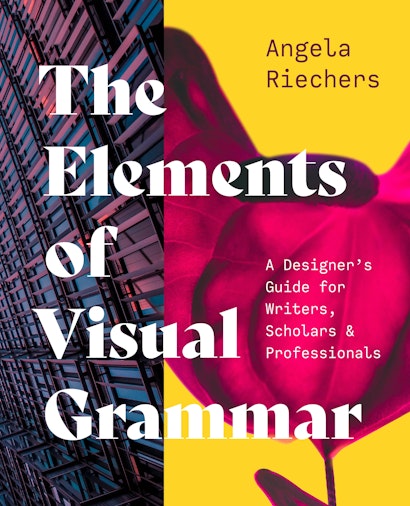When it comes time to use images to support a written report, a presentation, or a publication, oftentimes people find themselves stumped. The early years of education introduce students to the building blocks of verbal literacy, but very few of us are taught the ways in which images communicate their magic. It’s a pity—when images support both the feeling and content of the text, words and pictures unite to become an inseparable joined narrative.
Fortunately, rules of visual grammar exist alongside the rules of grammatical usage for written language. They provide a set of flexible principles for using images with clarity, directness, and precision. Some of visual grammar’s most useful tools include symbolism, metaphor, and iconography. Unlike written text which can communicate unambiguous meaning, visual language is not often as clear-cut. An object can serve as both a symbol and an icon, or a metaphor and a symbol. Usage, context, and shared cultural knowledge make the author’s intention clear to a viewer.
To break down the functionality of these three visual grammar principles, let’s begin with a simple starting point: the apple. Beyond its literal, not very appealing Webster’s definition: “The fleshy, usually rounded and red or yellow edible pome fruit of a tree [genus Malus] of the rose family,” the apple has multiple symbolic, metaphoric, and iconographic meanings throughout history and world cultures. It carries a range of disparate associations including fertility, youth, health, discord, evil, goodness, beauty, wealth, power, and salvation.
Symbolism allows an object or being to stand in for something else, adding a hidden layer of meaning. In the Biblical tale of Adam and Eve’s expulsion from the Garden of Eden, the apple proffered by the serpent (itself a symbol of evil), symbolizes the loss of innocence. In a related usage, the Wicked Stepmother, another personification of evil, offers Snow White a poisoned apple—a seemingly innocuous gift that symbolizes great harm.
“An apple a day keeps the doctor away,” uses the apple as a symbol of overall good health, while “He’s a rotten apple” relies upon its positive connotation with health to convey its opposite. For a visual grammar example, let’s consider a text about the damage done to a business by a corrupt executive. A photograph of a bowl of apples where all are shiny and fresh except for one that’s brown and wrinkled conveys that although the rotten apple is still part of the group (the business), it will spread its decay to all it touches. The reader will quickly understand the connection between text and image.
Metaphors compare two things to represent something else, allowing a viewer to make the connection between the literal item and a more abstract idea or concept it points to. For instance, for a text about a student who is having difficulty with a particular teacher, you could use images of crumpled test pages or report cards marked with failing grades. But a more imaginative choice would be an image of a child rolling a giant apple up a hill. Replace Sisyphus’s rock in his endlessly frustrating task with an apple for the teacher (which also suggests a student who would like to become the apple of the teacher’s eye), swap in the child as the main character, and you’ve depicted the struggle in a more sophisticated way.
The phrase “apple of my eye” refers to someone or something cherished or loved above all else, comparing the apple’s connection to wellbeing to the pupil of the eye, which is essential for sight. If you are comparing apples to oranges, you’re using the disparate qualities of the fruits—crisp and dry vs. soft and juicy, a thin skin vs. a thick rind—as a metaphor for things that are very much unlike.
And if you call New York City the Big Apple, you’re primarily saying that the city is A. the top of the crop/the big time, and secondarily B. as good as a nice, healthy apple. Big Apple as a nickname for New York City took hold during the 1920s jazz era. Although the term was popular amongst jazz musicians, it was John J. Fitz Gerald, who wrote a regular racing column for the New York Morning Telegraph, who is credited for bringing it into popular usage. In 1924 he wrote, “There’s only one Big Apple. That’s New York.”
Iconography uses images to convey cultural or historical context or symbolic meanings. Apple Computers was named on a whim, when founder Steve Jobs was on a fruitarian diet and had just come back from visiting an orchard in Oregon. Jobs recognized that as a corporate icon, the apple’s positive associations would lead consumers to feel comfortable (rather than intimidated) about joining the personal computer revolution.
A student who brings an apple for the teacher hopes to curry favor with a small gift carrying a mostly wholesome meaning—most teachers receiving an apple do not immediately think of Snow White’s stepmother and her evil motives. An apple polisher, usually an adult transparently flattering another in order to get ahead, is adding sheen to an already shining object. (Note that the phrase itself is more of a metaphor comparing an imaginary activity to the actual behavior, but the apple remains an icon of virtue.)
The apple’s role in mythology’s Judgement of Paris uses this simple fruit as an icon of the origin of war. When Eris, goddess of discord, was not invited to the wedding of Peleus and Thetis, she threw a golden apple inscribed, “To the fairest one,” into the wedding festivities. Goddesses Hera, Athena and Aphrodite fought over it and asked Paris of Troy to decide which of them deserved the prize. Paris chose Aphrodite. When he carried Helen off to Troy, the Greeks invaded to win her back, kicking off the Trojan War.
In visual grammar terms, an image of a golden apple with a bomb’s fuse replacing its stem, paired with a text about an impending war, updates this historical iconography while avoiding the visual clichés typically associated with armed conflict: battlefields, clouds of smoke, soldiers, guns. The restraint in the approach (using something delicate and shining to represent something brutal and deadly) is thought-provoking for a reader as well.
A great starting point when selecting images is to free-associate symbols, metaphors, and icons based on keywords from the written text. It then becomes an exercise in choosing which type of image will communicate the author’s message most clearly to a reader. Keep in mind that except in the case of journalism, the goal for images is not to match or mirror what the text is saying. Image choice should help a reader understand what’s between the lines; what’s suggested but not stated outright. In other words, show, don’t tell. Use a visual symbol, metaphor, or icon to enforce what you want the reader to take away from your text, and remember the numerous shared associations we have with the fleshy, usually rounded and red or yellow edible pome fruit of a tree [genus Malus] of the rose family.
Angela Riechers is Program Director of Graphic Design at the University of the Arts in Philadelphia. As an art director, she has created everything from page layouts for Harper’s Magazine to iPad apps for O, The Oprah Magazine. Riechers received a BFA from the Rhode Island School of Design and an MFA from the School of Visual Arts.

